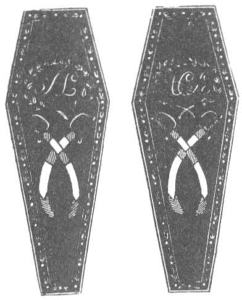A 2009 article in the New York Times reported that the price of an American funeral these days averages about $8,000.1 This staggering figure helps us understand how the funeral industry shovels in revenues in excess of $20 billion each year. And with the annual death rate not expected to decline until the mid 2020s, the industry of dying is anything but a dying industry.
With caskets starting at $1,500, coupled with the price of embalming, a cemetery plot, a headstone, and the services of a funeral director, the price shelled out for a final resting place can quickly rise.
The thing is, the American way of death has always followed the ebb and flow of fashion, and has been as variable through the centuries as domestic architecture and clothing.


New England Puritans often spent vast sums burying the deceased. While the coffin and a carved slate headstone accounted for some of the cost, much of the cash was spent on the living. Mourning rings and suits, bell ringers at the meetinghouse, hearse and the horse to pull it, gloves for the mourners, and hearty amounts of food and drink increased the bill. In fact, it was not unusual for funeral expenses to eat up twenty percent of the deceased’s estate.
The expenditures at last became so burdensome (and so out of keeping with the moral aesthetics of the Puritan theocracy), that Massachusetts passed sumptuary laws in 1721 restricting the amount people could spend on funeral gifts and trappings.2 Sixty years later, people had become so lackadaisical in their treatment of the dead, Massachusetts legislators found it necessary to pass laws to ensure that they received at least a modicum of care.3
Death rates in America fell during the course of the 18th and early 19th centuries, but that didn’t mean death ceased to be visible part of everyday life. For the sailors who manned the ships of the early United States Navy, premature death almost seemed the rule rather than the exception. Falls, drownings, and violent deaths occurred all the time. Disease spread among a crew with ease, and in southern climates especially, yellow fever, malaria, or a host of other ailments could decimate seamen and officers alike.
The Navy’s bean-counters neatly filed away the expenses incurred for burying seamen and officers just as efficiently as they did purchases of door nails or copper sheathing. At sea, burials tended to be simple, quick affairs. But on shore, decorum and fashion demanded more care and elaboration.
Usually, the Federal government bore these expenses. The elaborateness of the burial depended in large measure on the rank of the individual who died.


When Lieutenant Benjamin Turner crossed the bar at New Orleans in 1807, his funeral cost $88.07, or more than twice what he made per month while alive. Mr. Charles Depre provided 40 feet of cherry boards for his coffin. New Orleans milliners supplied 67 yards of black crepe to drape the coffin and hearse. There were 50 funeral cards (and a “carrier” to distribute them). The Reverend Philander Chase charged $20 for his “offices” at the funeral, and lest he appear improperly attired, he needed a sash of cambric muslin and black ribbon for his hat. The sexton, Henry Mitchell, submitted a bill for the use of the hearse and pall ($4) and for burying Lt. Turner ($4).4 Altogether, the funeral must have been a fitting, if somber, send off for one the Navy’s promising young officers.
The expense for burying common seamen seemed paltry by comparison. When sailor John Thompson died in March 1813, his funeral cost $18.25. Undertaker John F. Nooton nickel and dimed the Navy Department. He charged for digging the grave (eight feet deep, and $.50 extra because the ground was frozen), for a coffin and pall, for using the “Funeral Car” and the horse to pull it, for filling out the death certificate, for tolling the bell, for laying the corpse in the coffin, and for caring the corpse to the grave.5 These charges seem elaborate compared to those paid for the burial of USS Guerriere Seaman William White. When he died in Philadelphia in September 1814, he was placed in a “stained coffin” costing $7 and the “horse, hearst & Grave” cost another $2.6
If nothing else, it is surprising the Navy willingly incurred these expenses. At a time when the Navy Department was extremely parsimonious, questioning nearly every expenditure, the sums it spent to convey its officers and men to their final resting places convey a sense of obligation and care that was substantiated by other aspects of naval life. The Navy took care of its own.
1 Glaser, Gabrielle. “The Funeral: Your Last Chance to be a Big Spender,” The New York Times. April 18, 2009.
2 David E. Stannard, The Puritan Way of Death: A Study in Religion, Culture, and Social Change (New York: Oxford University Press, 1977), 112-115.
3 Ibid., 159-160.
4 Benjamin Turner accounts, Fourth Auditor of the Treasury, Numerical Accounts, No. 6359, RG 217, NARA.
5 John Nooton bill to Josiah Snelling, 23 March 1813, in Henry B. Rapp settled accounts, Fourth Auditor of the Treasury, Numerical Accounts, RG 217, NARA.
6 George Ritter receipt, 21 September 1814, Fourth Auditor of the Treasury, Numerical Accounts No. 908, RG 217, NARA.
The Author(s)
Matthew Brenckle
Research Historian, USS Constitution Museum
Matthew Brenckle was the Research Historian at the USS Constitution Museum from 2006 to 2016.
